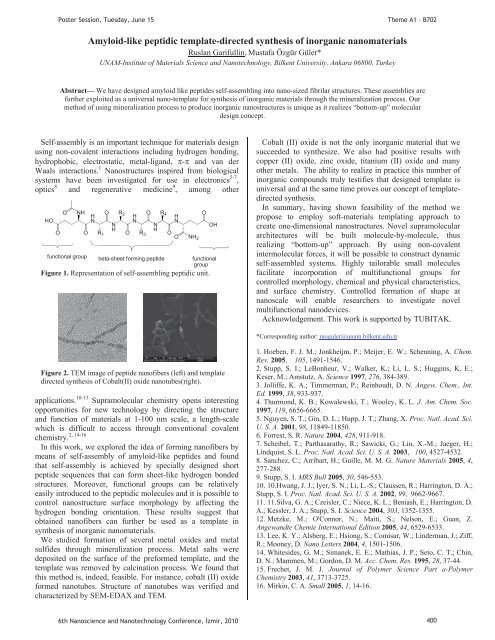Photonic crystals in biology
Photonic crystals in biology
Photonic crystals in biology
Create successful ePaper yourself
Turn your PDF publications into a flip-book with our unique Google optimized e-Paper software.
Poster Session, Tuesday, June 15<br />
Theme A1 - B702<br />
Amyloid-like peptidic template-directed synthesis of <strong>in</strong>organic nanomaterials<br />
Ruslan Garifull<strong>in</strong>, Mustafa Özgür Güler*<br />
UNAM-Institute of Materials Science and Nanotechnology, Bilkent University, Ankara 06800, Turkey<br />
Abstract— We have designed amyloid like peptides self-assembl<strong>in</strong>g <strong>in</strong>to nano-sized fibrilar structures. These assemblies are<br />
further exploited as a universal nano-template for synthesis of <strong>in</strong>organic materials through the m<strong>in</strong>eralization process. Our<br />
method of us<strong>in</strong>g m<strong>in</strong>eralization process to produce <strong>in</strong>organic nanostructures is unique as it realizes “bottom-up” molecular<br />
design concept.<br />
Self-assembly is an important technique for materials design<br />
us<strong>in</strong>g non-covalent <strong>in</strong>teractions <strong>in</strong>clud<strong>in</strong>g hydrogen bond<strong>in</strong>g,<br />
hydrophobic, electrostatic, metal-ligand, - and van der<br />
Waals <strong>in</strong>teractions. 1 Nanostructures <strong>in</strong>spired from biological<br />
systems have been <strong>in</strong>vestigated for use <strong>in</strong> electronics 5-7 ,<br />
optics 8 and regenerative medic<strong>in</strong>e 9 , among other<br />
HO<br />
O<br />
O<br />
NH<br />
O<br />
functional group<br />
H<br />
N<br />
R 1<br />
O<br />
N<br />
H<br />
R 2<br />
O<br />
O R<br />
H<br />
4<br />
O<br />
H<br />
N<br />
N<br />
N<br />
R H<br />
OH<br />
3 O<br />
O NH 2<br />
beta-sheet form<strong>in</strong>g peptide<br />
functional<br />
group<br />
Figure 1. Representation of self-assembl<strong>in</strong>g peptidic unit.<br />
Cobalt (II) oxide is not the only <strong>in</strong>organic material that we<br />
succeeded to synthesize. We also had positive results with<br />
copper (II) oxide, z<strong>in</strong>c oxide, titanium (II) oxide and many<br />
other metals. The ability to realize <strong>in</strong> practice this number of<br />
<strong>in</strong>organic compounds truly testifies that designed template is<br />
universal and at the same time proves our concept of templatedirected<br />
synthesis.<br />
In summary, hav<strong>in</strong>g shown feasibility of the method we<br />
propose to employ soft-materials templat<strong>in</strong>g approach to<br />
create one-dimensional nanostructures. Novel supramolecular<br />
architectures will be built molecule-by-molecule, thus<br />
realiz<strong>in</strong>g “bottom-up” approach. By us<strong>in</strong>g non-covalent<br />
<strong>in</strong>termolecular forces, it will be possible to construct dynamic<br />
self-assembled systems. Highly tailorable small molecules<br />
facilitate <strong>in</strong>corporation of multifunctional groups for<br />
controlled morphology, chemical and physical characteristics,<br />
and surface chemistry. Controlled formation of shape at<br />
nanoscale will enable researchers to <strong>in</strong>vestigate novel<br />
multifunctional nanodevices.<br />
Acknowledgement. This work is supported by TUBITAK.<br />
*Correspond<strong>in</strong>g author: moguler@unam.bilkent.edu.tr<br />
Figure 2. TEM image of peptide nanofibers (left) and template<br />
directed synthesis of Cobalt(II) oxide nanotubes(right).<br />
applications. 10-13 Supramolecular chemistry opens <strong>in</strong>terest<strong>in</strong>g<br />
opportunities for new technology by direct<strong>in</strong>g the structure<br />
and function of materials at 1-100 nm scale, a length-scale<br />
which is difficult to access through conventional covalent<br />
2, 14-16<br />
chemistry.<br />
In this work, we explored the idea of form<strong>in</strong>g nanofibers by<br />
means of self-assembly of amyloid-like peptides and found<br />
that self-assembly is achieved by specially designed short<br />
peptide sequences that can form sheet-like hydrogen bonded<br />
structures. Moreover, functional groups can be relatively<br />
easily <strong>in</strong>troduced to the peptidic molecules and it is possible to<br />
control nanostructure surface morphology by affect<strong>in</strong>g the<br />
hydrogen bond<strong>in</strong>g orientation. These results suggest that<br />
obta<strong>in</strong>ed nanofibers can further be used as a template <strong>in</strong><br />
synthesis of <strong>in</strong>organic nanomaterials.<br />
We studied formation of several metal oxides and metal<br />
sulfides through m<strong>in</strong>eralization process. Metal salts were<br />
deposited on the surface of the preformed template, and the<br />
template was removed by calc<strong>in</strong>ation process. We found that<br />
this method is, <strong>in</strong>deed, feasible. For <strong>in</strong>stance, cobalt (II) oxide<br />
formed nanotubes. Structure of nanotubes was verified and<br />
characterized by SEM-EDAX and TEM.<br />
1. Hoeben, F. J. M.; Jonkheijm, P.; Meijer, E. W.; Schenn<strong>in</strong>g, A. Chem.<br />
Rev. 2005, 105, 1491-1546.<br />
2. Stupp, S. I.; LeBonheur, V.; Walker, K.; Li, L. S.; Hugg<strong>in</strong>s, K. E.;<br />
Keser, M.; Amstutz, A. Science 1997, 276, 384-389.<br />
3. Jolliffe, K. A.; Timmerman, P.; Re<strong>in</strong>houdt, D. N. Angew. Chem., Int.<br />
Ed. 1999, 38, 933-937.<br />
4. Thurmond, K. B.; Kowalewski, T.; Wooley, K. L. J. Am. Chem. Soc.<br />
1997, 119, 6656-6665.<br />
5. Nguyen, S. T.; G<strong>in</strong>, D. L.; Hupp, J. T.; Zhang, X. Proc. Natl. Acad. Sci.<br />
U. S. A. 2001, 98, 11849-11850.<br />
6. Forrest, S. R. Nature 2004, 428, 911-918.<br />
7. Scheibel, T.; Parthasarathy, R.; Sawicki, G.; L<strong>in</strong>, X.-M.; Jaeger, H.;<br />
L<strong>in</strong>dquist, S. L. Proc. Natl. Acad. Sci. U. S. A. 2003, 100, 4527-4532.<br />
8. Sanchez, C.; Arribart, H.; Guille, M. M. G. Nature Materials 2005, 4,<br />
277-288.<br />
9. Stupp, S. I. MRS Bull 2005, 30, 546-553.<br />
10. 10.Hwang, J. J.; Iyer, S. N.; Li, L.-S.; Claussen, R.; Harr<strong>in</strong>gton, D. A.;<br />
Stupp, S. I. Proc. Natl. Acad. Sci. U. S. A. 2002, 99, 9662-9667.<br />
11. 11.Silva, G. A.; Czeisler, C.; Niece, K. L.; Beniash, E.; Harr<strong>in</strong>gton, D.<br />
A.; Kessler, J. A.; Stupp, S. I. Science 2004, 303, 1352-1355.<br />
12. Metzke, M.; O'Connor, N.; Maiti, S.; Nelson, E.; Guan, Z.<br />
Angewandte Chemie International Edition 2005, 44, 6529-6533.<br />
13. Lee, K. Y.; Alsberg, E.; Hsiong, S.; Comisar, W.; L<strong>in</strong>derman, J.; Ziff,<br />
R.; Mooney, D. Nano Letters 2004, 4, 1501-1506.<br />
14. Whitesides, G. M.; Simanek, E. E.; Mathias, J. P.; Seto, C. T.; Ch<strong>in</strong>,<br />
D. N.; Mammen, M.; Gordon, D. M. Acc. Chem. Res. 1995, 28, 37-44.<br />
15. Frechet, J. M. J. Journal of Polymer Science Part a-Polymer<br />
Chemistry 2003, 41, 3713-3725.<br />
16. Mirk<strong>in</strong>, C. A. Small 2005, 1, 14-16.<br />
6th Nanoscience and Nanotechnology Conference, zmir, 2010 400













